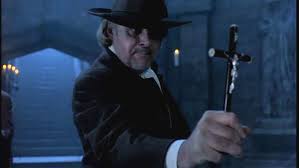It is the third-person narration that makes John Keats’ poem “La Belle Dame sans Merci” (1819) peculiar as a ballad. The poem opens with two descriptive third-person “objective” narration stanzas in which the poet sets the environment. We are in an idyllic dark location where a “knight-at-arms” (line 1) ails “alone and palely loitering”, being also “haggard and so woe-begone” (line 6).
The poem suddenly changes towards a more subjective narration, the audience can’t easily understand who “I” is who is telling the story until the very last stanza where the narrator is indeed the knight-at-arms that “sojourn[s t]here, alone and palely loitering” (lines 45-46).

The question here is who is this Belle Dame? Weirdly described as “a faery’s child” (line 14), with “wild” (line 16) eyes, this woman can easily make our narrator fall in love with her and vice versa, because she tells him “I love thee true” (line 28) even if she spoke “in language strange” (line 27). Everything happening between the two is so fast that once we read “there I dreamed – Ah! Woe betide! – the latest dream I ever dreamt” (lines 34-35), we feel relieved because we realize that she is a demon-like figure that kills men by seducing, abducting, deceiving, and eventually using them for her own pleasure. She is, after all, what the other fate-like “kings and prince” (line 37) tell him, she is “La Belle Dame sans Merci [that] thee hath in thrall!” (lines 39-30).
I would argue that she does not represent what many critics say she represents: the femme fatale that puts a man to disgrace. Back when he was writing this poem, John Keats had recently found out about his disease that would have surely brought him to death. Because of this, one can tell that he focused his lyrical attention on death. In this poem, the elfin-fairy woman is perhaps death itself. He cannot say no to her, she appears out of nowhere, she killed brave “warriors” (line 38) before him, and eventually “lulled [him] asleep” (line 33). There’s nothing that, metaphorically speaking, can’t refer to death, particularly if the first thing he sees is the flower of death:
“I see a lily” (line 9).

